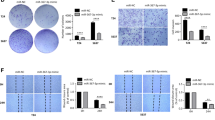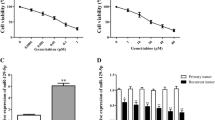Abstract
Objectives
Radiotherapy is the primary option for bladder cancer patients, but it does not have obvious curative effects. This study was to investigate how to increase radiosensitivity in bladder cancer.
Materials and Methods
The curcumin and irradiation treated T24 cells were used for analysis of microRNA expression (miRNA microarray), cell viability (Cell Proliferation Assay Kit), colony formation, apoptosis (Annexin V-FITC/7-AAD flow cytometry), miR-1246 and p53 mRNA (real-time PCR) and protein (Western blot) expression.
Results
Microarray assay identified 17 differentially expressed miRNAs (twofold change) in curcumin treated cells compared to control cells. Among them, miR-1246 was the miRNA with the largest change in expression after curcumin treatment. Curcumin significantly decreased T24 cell viability and colony formation in a concentration-dependent manner compared to control cells. miR-1246 expression was significantly higher in T24 cells than in SV-HUC-1 cells and the higher concentrations (10 or 20 μM) of curcumin significantly down-regulated miR-1246 expression in T24 and HT-1376 cells. The combination of 10 µM curcumin and irradiation was more effective in decreasing miR-1246 expression, cell viability and colony formation than curcumin or irradiation alone. Inhibition of miR-1246 significantly decreased cell viability and colony formation in T24 and HT-1376 cells. Transfection with antagomiR-1246 significantly increased the G0/G1-phase of T24 cells and induced apoptosis compared to cells transfected with antagomiR-NC. Luciferase reporter assay showed that the overexpression of miR-1246 suppressed the luciferase activity of the P53 3′-UTR reporter genes.
Conclusion
miR-1246 is involved in the anti-cancer effects of curcumin and irradiation through targeting the inhibition of p53 gene translation in bladder cancer cells.




Similar content being viewed by others
References
Chen W, Zheng R, Baade PD, Zhang S, Zeng H, Bray F, Jemal A, Yu XQ, He J (2016) Cancer statistics in China, 2015. CA Cancer J Clin 66:115–132
Walker M, French SD, Doron RC, Brennan K, Feldman-Stewart D, Siemens DR, Mackillop WJ, Booth CM (2017) Bladder-sparing radiotherapy for muscle-invasive bladder cancer: a survey of providers to determine barriers and enablers. Radiother Oncol 125:351–356. https://doi.org/10.1016/j.radonc.2017.08.036
Hautmann RE, de Petriconi RC, Volkmer BG (2010) Lessons learned from 1000 neobladders: the 90-day complication rate. J Urol 184:990–994
Alfred Witjes J, Lebret T, Compérat EM, Cowan NC, De Santis M, Bruins HM, Hernández V, Espinós EL, Dunn J, Rouanne M, Neuzillet Y, Veskimäe E, van der Heijden AG, Gakis G, Ribal MJ (2017) Updated 2016 EAU guidelines on muscle-invasive and metastatic bladder cancer. Eur Urol 71:462–475
Verma V (2016) Relationship and interactions of curcumin with radiation therapy. World J Clin Oncol 7:275–283
Chendil D, Ranga RS, Meigooni D, Sathishkumar S, Ahmed MM (2004) Curcumin confers radiosensitizing effect in prostate cancer cell line PC-3. Oncogene 23:1599–1607
Li M, Zhang Z, Hill DL, Wang H, Zhang R (2007) Curcumin, a dietary component, has anticancer, chemosensitization, and radiosensitization effects by down-regulating the MDM2 oncogene through the PI3K/mTOR/ETS2 pathway. Cancer Res 67:1988–1996
Takhtfooladi MA, Asghari A, Takhtfooladi HA, Shabani S (2015) The protective role of curcumin on testicular tissue after hindlimb ischemia reperfusion in rats. Int Urol Nephrol 47:1605–1610
Tharakan ST, Inamoto T, Sung B, Aggarwal BB, Kamat AM (2010) Curcumin potentiates the antitumor effects of gemcitabine in an orthotopic model of human bladder cancer through suppression of proliferative and angiogenic biomarkers. Biochem Pharmacol 79:218–228
Kamat AM, Sethi G, Aggarwal BB (2007) Curcumin potentiates the apoptotic effects of chemotherapeutic agents and cytokines through down-regulation of nuclear factor-kappaB and nuclear factor-kappaB-regulated gene products in IFN-alpha-sensitive and IFN-alpha-resistant human bladder cancer cells. Mol Cancer Ther 6:1022–1030
Kang M, Ho JN, Kook HR, Lee S, Oh JJ, Hong SK, Lee SE, Byun SS (2016) Theracurmin® efficiently inhibits the growth of human prostate and bladder cancer cells via induction of apoptotic cell death and cell cycle arrest. Oncol Rep 35:1463–1472
Mohammadi A, Mansoori B, Baradaran B (2017) Regulation of miRNAs by herbal medicine: an emerging field in cancer therapies. Biomed Pharmacother 86:262–270
Korpela E, Vesprini D, Liu SK (2015) MicroRNA in radiotherapy: miRage or miRador? Br J Cancer 112:777–782
Momtazi AA, Shahabipour F, Khatibi S, Johnston TP, Pirro M, Sahebkar A (2016) Curcumin as a microRNA regulator in cancer: a review. Rev Physiol Biochem Pharmacol 171:1–38
Tian B, Wang Z, Zhao Y, Wang D, Li Y, Ma L, Li X, Li J, Xiao N, Tian J, Rodriguez R (2008) Effects of curcumin on bladder cancer cells and development of urothelial tumors in a rat bladder carcinogenesis model. Cancer Lett. 264:299–308
Park BH, Lim JE, Jeon HG, Seo SI, Lee HM, Choi HY, Jeon SS, Jeong BC (2016) Curcumin potentiates antitumor activity of cisplatin in bladder cancer cell lines via ROS-mediated activation of ERK1/2. Oncotarget. 7:63870–63886
Wang F, Tang J, Li P, Si S, Yu H, Yang X, Tao J, Lv Q, Gu M, Yang H, Wang Z (2018) Chloroquine enhances the radiosensitivity of bladder cancer cells by inhibiting autophagy and activating apoptosis. Cell Physiol Biochem 45:54–66
Li H, Xie H, Liu W, Hu R, Huang B, Tan YF, Xu K, Sheng ZF, Zhou HD, Wu XP, Luo XH (2009) A novel microRNA targeting HDAC5 regulates osteoblast differentiation in mice and contributes to primary osteoporosis in humans. J Clin Invest 119:3666–3677
Cheng P, Chen C, He HB, Hu R, Zhou HD, Xie H, Zhu W, Dai RC, Wu XP, Liao EY, Luo XH (2013) miR-148a regulates osteoclastogenesis by targeting V-maf musculoaponeurotic fibrosarcoma oncogene homolog B. J Bone Miner Res 28:1180–1190
Kim JH, Ahn JH, Lee M (2017) Upregulation of microRNA-1246 is associated with BRAF inhibitor resistance in melanoma cells with mutantBRAF. Cancer Res Treat 49:947–959
Takeshita N, Hoshino I, Mori M, Akutsu Y, Hanari N, Yoneyama Y, Ikeda N, Isozaki Y, Maruyama T, Akanuma N, Komatsu A, Jitsukawa M, Matsubara H (2013) Serum microRNA expression profile: miR-1246 as a novel diagnostic and prognostic biomarker for oesophageal squamous cell carcinoma. Br J Cancer 108:644–652
Todeschini P, Salviato E, Paracchini L, Ferracin M, Petrillo M, Zanotti L, Tognon G, Gambino A, Calura E, Caratti G, Martini P, Beltrame L, Maragoni L, Gallo D, Odicino FE, Sartori E, Scambia G, Negrini M, Ravaggi A, D'Incalci M, Marchini S, Bignotti E, Romualdi C (2016) Circulating miRNA landscape identifies miR-1246 as promising diagnostic biomarker in high-grade serous ovarian carcinoma: a validation across two independent cohorts. Cancer Lett 388:320–327
Yang Y, Xie YJ, Xu Q, Chen JX, Shan NC, Zhang Y (2015) Down-regulation of miR-1246 in cervical cancer tissues and its clinical significance. Gynecologic Oncol 138:683–688
Sakha S, Muramatsu T, Ueda K, Inazawa J (2016) Exosomal microRNA miR-1246 induces cell motility and invasion through the regulation of DENND2D in oral squamous cell carcinoma. Sci Rep 6:38750
Wang S, Zeng Y, Zhou JM, Nie SL, Peng Q, Gong J, Huo JR (2016) MicroRNA-1246 promotes growth and metastasis of colorectal cancer cells involving CCNG2 reduction. Mol Med Rep 13:273–280
Ciccarese C, Massari F, Blanca A, Tortora G, Montironi R, Cheng L, Scarpelli M, Raspollini MR, Vau N, Fonseca J, Lopez-Beltran A (2017) Tp53 and its potential therapeutic role as a target in bladder cancer. Expert Opin Ther Targets 21:401–414
Papadogianni D, Soulitzis N, Delakas D, Spandidos DA (2014) Expression of p53 family genes in urinary bladder cancer: correlation with disease aggressiveness and recurrence. Tumor Biol 35:2481–2489
Zhang Y, Liao JM, Zeng SX, Lu H (2011) p53 downregulates down syndrome-associated DYRK1A through miR-1246. EMBO Rep 12:811–817
Zhang Q, Cao LY, Cheng SJ, Zhang AM, Jin XS, Li Y (2015) p53-induced microRNA-1246 inhibits the cell growth of human hepatocellular carcinoma cells by targeting NFIB. Oncol Rep 33:1335–1341
Funding
This work was supported by National Natural Science Foundation of China (81601230), and Natural Science Foundation of Hunan Province (2016JJ3178).
Author information
Authors and Affiliations
Contributions
The manuscript has been read and approved by all the authors and all authors believe that the manuscript represents honest work.
Corresponding author
Ethics declarations
Conflict of interest
All authors declared no conflict of interest.
Statement of animals and human participants
This article does not contain any studies with animals and human participants performed by any of the authors.
Additional information
Publisher's Note
Springer Nature remains neutral with regard to jurisdictional claims in published maps and institutional affiliations.
Rights and permissions
About this article
Cite this article
Xu, R., Li, H., Wu, S. et al. MicroRNA-1246 regulates the radio-sensitizing effect of curcumin in bladder cancer cells via activating P53. Int Urol Nephrol 51, 1771–1779 (2019). https://doi.org/10.1007/s11255-019-02210-5
Received:
Accepted:
Published:
Issue Date:
DOI: https://doi.org/10.1007/s11255-019-02210-5




